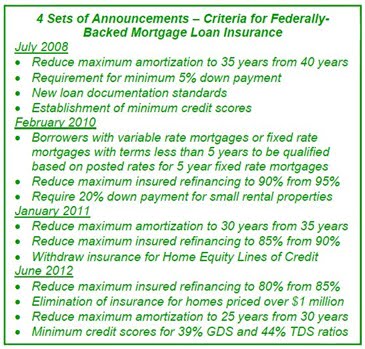“…The changes to mortgage insurance criteria are unnecessarily jeopardizing the health of Canada’s housing markets and the broader economy.”
 That’s the conclusion from economist Will Dunning in CAAMP’s just-released State of the Residential Mortgage Market report. (Link)
That’s the conclusion from economist Will Dunning in CAAMP’s just-released State of the Residential Mortgage Market report. (Link)
Dunning says his research suggests the Finance Department has created “a policy-induced housing market downturn” that could reinforce existing weakness.
He calculates that the most recent (July 2012) rule changes will knock 11% of potential high-ratio homebuyers out of the market—that is, until they can come up with more net income or a bigger down payment.
He lays out the following arguments:
Jobs underpin the market…
 “Job creation is the key driver of housing demand” writes Dunning.
“Job creation is the key driver of housing demand” writes Dunning.- “The ‘housing wealth’ effect (the increased confidence, and willingness to spend and invest, that results from rising house prices) is the single most important driver of job creation”
- What’s more, in the prior five years, 18% of job creation in Canada has originated from housing and mortgage activity.
- If mortgage rule tightening drives down home prices, job creation will suffer and it could trigger a negative “feedback” loop between the housing market and the economy.
Price risk…
- Dunning writes: “Experience around the world has shown that once house prices start to fall, the outcome is unpredictable, and can turn into a downward spiral that wreaks substantial economic damage.”
- He adds: “It can happen that the loss of jobs affects housing demand, leading to further price drops and a vicious downward spiral.”
- There is growing evidence to suggest that the combined mortgage rule changes of the past four years may now be “significant enough to substantially reduce housing activity.”
What’s happened so far…
- The government has handed down four sets of insured mortgage restrictions since July 2008. Dunning summarizes them in the list below:
(Source: Will Dunning)
- He says the cumulative effect of these four sets of changes “have resulted in a massive contraction in credit availability.”
- From August to October, home sales were 7.8% lower than the prior year.
- Some analysts downplay the effects of past mortgage rule changes, pointing to the subsequent sales rebounds that took place.
- Dunning notes that those rebounds coincided with falling mortgage rates. “It appears that the movements of mortgage rates were more important than the changes in the mortgage insurance criteria,” he says.
The effects…
 “16.9% of high-ratio mortgages that were funded in 2010 could not have been funded under the revised criteria.”
“16.9% of high-ratio mortgages that were funded in 2010 could not have been funded under the revised criteria.”- “…The final set of changes that was announced in June 2012 and took effect in July will have had the most significant consequences, accounting for about 65% of the impact (11.0% out of 16.9%).”
Time for young buyers to save up…
- “…Simulations indicate that on average (based on 2010 real mortgage data), the additional down payment required is about $25,000, 7% of the purchase price.” That’s what it takes to offset the mortgage rule effect.
- “If we assume that these households can devote 10% of their pre-tax incomes to enlarging their down payments, on average it will take 3.5 years to re-qualify – and this assumes that house prices and interest rates do not increase.(10% may be optimistic. Doug Porter recently estimated that the median family saves only 4%, or $2,800 a year.)
What happens next…
- 55% of buyers need high-ratio mortgages, according to Maritz. “If 16.9% of potential high ratio buyers are removed from the market, this would reduce total home sales by about 9%,” Dunning states.
- “…It will become more difficult for people who want to move-up in the market to sell their current home. In consequence, over time, we should expect to see reduced activity in upper segments of the market.”
- “…Declines in activity will be partly (and gradually) mitigated, as some of the affected potential buyers save additional down payments and can return to the housing market.”
- “…It now appears that the 2010 changes had a lasting negative effect (on home sales).”
- “…the negative effects on housing activity will be quite prolonged…the damage is not yet fully developed.”
Was it necessary?
- “The average resale house price in Canada had been essentially flat since early 2011,” Dunning says. On top of that we faced (and still face) material risks from the U.S., Europe and from domestic budget tightening.
- “There was no need to further cool the housing market,” he concludes.
*******
Stricter mortgage rules will be a drag on demand until the market has time to adjust. Let’s just hope the new rules aren’t coupled with an economic slowdown or a natural cyclical home price correction. In that case, the latest rule changes could prove to be very bad timing.
Of course, low rates could always save the day once again—or delay an inevitable correction if you want to look at it that way. We could also see buyers get off the sidelines and purchase on dips—i.e., buy if home prices drop 10% or so. Both of those factors could pad a fall, at least somewhat.
Rob McLister, CMT





These new mortgage rules were welcomed in Manitoba, Saskatchewan, + Alberta. The strengthing of our future with more secured financed homes will cause us to be stronger in the long run.
As agents in Winnipeg, we felt a slight levelling off of sales and some financed deals fall through, but we have to look at the big picture and accept what is good for the Country as a whole. People will get used to the new rules and have to save for an extra 6 months, but then won’t be house poor like they would of been before.
There is life outside of Toronto and Vancouver.
OMG no! First time home buyers might need to save more or get a higher paying job to buy a house? The horror!
Sorry about your reading impediment. First timers might now need to save 6 more YEARS, not 6 months.
Ya you don’t care much do you Brett? I mean really, who cares if your neighbour loses his job or young Canadians are forced to pay a landlord for another 6 years?
It’s regrettable the mortgage rules were loosened back in 2006. So much harm could have been avoided without the 40 year amortization experiment.
@Fizz,
If house prices become affordable, 6 years of saving will quickly become 6 months. That’s a good thing, unless you’re a speculator.
More money in homeowners’ pockets. More to invest in productive assets. More to spend on things rather than interest payments to banks.
The new rules are really the old rules from a just few years ago.
Agreed.
It’s much more important that young Canadians pay the interest and fees on the largest possible mortgages to banks/brokers.
Funny, didn’t remember CAAMP complaining about government interference when the 0% down, 40 year amortization mortgages were introduced in 2006. The housing market worked well for decades with 10% down and 25 year amortization mortgages. Even after “round 4”, the CMHC rules are still more generous than what we had in 2000. CAAMP should stop its whining.
“Even after “round 4″, the CMHC rules are still more generous than what we had in 2000.”
If that is really what you think, you are pitifully underinformed.
Falling home values will be horrible for seniors who rely on their home equity for retirement. How fortunate that Mr. Flaherty doesn’t need to worry about retirement with his fat government pension.
Please inform us.
The result of the mortgage rule changes should have the desired effects of
1.) Reducing prices towards the long-run means and within economic fundamentals.
2.) Reduce speculation
3.) Make housing more accessible through the lower prices.
This will allow Canada to reduce the misallocation of resources that has occurred over the past 10 years. All of us on the international investment community would welcome a decrease of prices in Canada of 30% in order to bring the economy back into equilibrium.
I guess you’re not a “Swiss Banker” who’s invested in Canadian bonds, equities or real estate. If you were, you’d be a masochist to want a 30% crash.
High home values are horrible for the young.
Tightening mortgage rules does exclude potential buyers from the marketplace. However, if you simply look at the June 2012 requirements, they do not seem out of line with what a prudent investor (financial institution) would / or should require. Federally Regulated Financial Institutions need to be protected from themselves, in most cases! For the non-qualified borrower, there is always non-regulated money available…